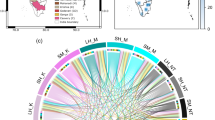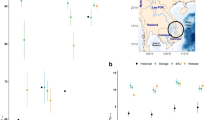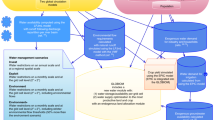Abstract
Emerging climate change mitigation policies focus on the implementation of global measures relying on carbon prices to attain rapid emissions reductions, with limited consideration for the impacts of global policies at local scales. Here, we use the Zambezi Watercourse in southern Africa to demonstrate how local dynamics across interconnected water–energy–food systems are impacted by mitigation policies. Our results indicate that climate change mitigation policies related to land-use change emissions can have negative side effects on local water demands, generating increased risks for failures across all the components of the water–energy–food systems in the Zambezi Watercourse. Analogous vulnerabilities could impact many river basins in southern and western Africa. It is critical to connect global climate change mitigation policies to local dynamics for a better exploration of the full range of possible future scenarios while supporting policy makers in prioritizing sustainable mitigation and adaptation solutions.
This is a preview of subscription content, access via your institution
Access options
Access Nature and 54 other Nature Portfolio journals
Get Nature+, our best-value online-access subscription
$29.99 / 30 days
cancel any time
Subscribe to this journal
Receive 12 print issues and online access
$209.00 per year
only $17.42 per issue
Buy this article
- Purchase on Springer Link
- Instant access to full article PDF
Prices may be subject to local taxes which are calculated during checkout




Similar content being viewed by others
Data availability
All climate data are freely available at the following websites: historical precipitation: https://chc.ucsb.edu/data/chirps, historical temperature: http://hydrology.princeton.edu/data.metdata_africa.php, projected precipitation and temperature: http://www.csag.uct.ac.za/cordex-africa/ (see Supplementary Table 3). Data about the socioeconomic scenarios produced by GCAM simulations are available in the Github repository: https://github.com/JRLamontagne/Factorial_SSP-SPA_Exploration. Bias-adjusted climate projections and corresponding simulated streamflow are available in the open-source repository https://doi.org/10.5281/zenodo.572694168. All the historical hydrologic data on the Zambezi River basin are from the Zambezi River Authority (ZRA) and were collected during the DAFNE project (http://dafne-project.eu/). They are protected by a nondisclosure agreement with ZRA. Source data are provided with this paper.
Code availability
The code of the HBV models is available in the open-source repository https://doi.org/10.5281/zenodo.572694169. Because the Zambezi Watercourse model described in Supplementary Section 2 contains sensitive hydrologic data, along with hydropower plant characteristics from ZRA, Zambia Electricity Supply Corporation (ZESCO) and Hidroeléctrica de Cahora Bassa (HCB), it cannot be made public. The simulation outputs and the code for generating the figures can be, however, found in the open-source repository https://doi.org/10.5281/zenodo.572694169.
References
Lamontagne, J., Reed, P., Marangoni, G., Keller, K. & Garner, G. Robust abatement pathways to tolerable climate futures require immediate global action. Nat. Clim. Change 9, 290–294 (2019).
Luderer, G. et al. Residual fossil CO2 emissions in 1.5–2 °C pathways. Nat. Clim. Change 8, 626–633 (2018).
van Vuuren, D., Hof, A., van Sluisveld, M. & Riahi, K. Open discussion of negative emissions is urgently needed. Nat. Energy 2, 902–904 (2017).
Santos Da Silva, S. et al. The Paris pledges and the energy–water–land nexus in Latin America: exploring implications of greenhouse gas emission reductions. PLoS ONE 14, e0215013 (2019).
Fujimori, S. et al. A multi-model assessment of food security implications of climate change mitigation. Nat. Sustain. 2, 386–396 (2019).
Rogelj, J., McCollum, D., O’Neill, B. & Riahi, K. 2020 emissions levels required to limit warming to below 2 °C. Nat. Clim. Change 3, 405–412 (2013).
Tavoni, M. et al. Post-2020 climate agreements in the major economies assessed in the light of global models. Nat. Clim. Change 5, 119–126 (2015).
Garner, G., Reed, P. & Keller, K. Climate risk management requires explicit representation of societal trade-offs. Climatic Change 134, 713–723 (2016).
Dearing, J. et al. Safe and just operating spaces for regional social–ecological systems. Glob. Environ. Change 28, 227–238 (2014).
Kling, H., Stanzel, P. & Preishuber, M. Impact modelling of water resources development and climate scenarios on Zambezi River discharge. J. Hydrol. Reg. Stud. 1, 17–43 (2014).
Payet-Burin, R., Kromann, M., Pereira-Cardenal, S., Strzepek, K. & Bauer-Gottwein, P. WHAT-IF: an open-source decision support tool for water infrastructure investment planning within the water–energy–food–climate nexus. Hydrol. Earth Syst. Sci. 23, 4129–4152 (2019).
Fant, C., Gebretsadik, Y., McCluskey, A. & Strzepek, K. An uncertainty approach to assessment of climate change impacts on the Zambezi River basin. Clim. Change 130, 35–48 (2015).
Spalding-Fechera, R., Joyceb, B. & Winklerc, H. Climate change and hydropower in the Southern African Power Pool and Zambezi River basin: system-wide impacts and policy implications. Energy Policy 103, 84–97 (2017).
GCAM v4.3 Documentation: Global Change Assessment Model (GCAM) (JGCRI, 2017).
Thomson, A. et al. RCP 4.5: a pathway for stabilization of radiative forcing by 2100. Clim. Change 109, 77–94 (2011).
Clarke, L. et al. in Climate Change 2014: Mitigation of Climate Change (eds Edenhofer, O. et al.) Ch. 6 (Cambridge Univ. Press, 2014).
Calvin, K. et al. The SSP4: a world of deepening inequality. Glob. Environ. Change 42, 284–296 (2017).
van Vuuren, D. et al. The shared socio-economic pathways: trajectories for human development and global environmental change. Glob. Environ. Change 42, 148–152 (2017).
Kriegler, E., Edmonds, J. & Hallegatte, S. A new scenario framework for climate change research: the concept of shared climate policy assumptions. Climatic Change 122, 401–414 (2014).
Riahi, K. et al. The shared socioeconomic pathways and their energy, land use, and greenhouse gas emissions implications: An overview. Glob. Environ. Change 42, 153–168 (2017).
Lamontagne, J. et al. Large ensemble analytic framework for consequence-driven discovery of climate change scenarios. Earth’s Future 6, 488–504, (2018).
Li, X. et al. Tethys–a Python package for spatial and temporal downscaling of global water withdrawals. J. Open Res. Softw. 6, 9 (2018).
Huang, Z. et al. Global agricultural green and blue water consumption under future climate and land use changes. J. Hydrol. 574, 242–256 (2019).
van Vuuren, D. et al. The representative concentration pathways: an overview. Climatic Change 109, 5–31 (2011).
Sadoff, C., Whittington, D. & Grey, D. Africa’s International Rivers: An Economic Perspective (World Bank, 2003).
Beilfuss, R. in The Wetland Book (ed. Finlayson, C.) 1–9 (Springer, 2016).
The Zambezi River Basin. A Multi-Sector Investment Opportunities Analysis (World Bank, 2010).
Jeuland, M. & Whittington, D. Water resources planning under climate change: assessing the robustness of real options for the Blue Nile. Water Resour. Res. 50, 2086–2107 (2014).
Warner, J. J. S., Jones, E., Ansari, M. & De Vries, L. The fantasy of the Grand Inga hydroelectric project on the River Congo. Water 11, 407 (2019).
Winemiller, K. et al. Balancing hydropower and biodiversity in the Amazon, Congo, and Mekong. Science 351, 128–129 (2016).
Conway, D. et al. Climate and southern Africa’s water–energy–food nexus. Nat. Clim. Change 5, 837–846 (2015).
Strategic Plan for the Zambezi Watercourse 2018–2040 (ZAMCOM, 2019).
Cervigni, R., Liden, R., Neumann, J. & Strzepek, K. Enhancing the Climate Resilience of Africa’s Infrastructure: The Power and Water Sectors (World Bank, 2015).
World Database of Key Biodiversity Areas (BirdLife International, 2018); www.keybiodiversityareas.org
Beilfuss, R. & dos Santos, D. Program for the Sustainable Management of Cahora Bassa Dam and the Lower Zambezi Valley. Working Paper http://www.xitizap.com/zambeze-hydrochanges.pdf (2001).
Coello Coello, C., Lamont, G. & Veldhuizen, D. V. Evolutionary Algorithms for Solving Multi-Objective Problems (Springer, 2007).
Tilmant, A., Beevers, L. & Muyunda, B. Restoring a flow regime through the coordinated operation of a multireservoir system: the case of the Zambezi River basin. Water Resour. Res. 46, W07533 (2010).
Rulli, M., Saviori, A. & D’Odorico, P. Global land and water grabbing. Proc. Natl Acad. Sci. USA 110, 892–897 (2013).
Zarfl, C., Lumsdon, A., Berlekamp, J., Tydecks, L. & Tockner, K. A global boom in hydropower dam construction. Aquat. Sci. 77, 161–170 (2015).
Graham, N. et al. Humans drive future water scarcity changes across all shared socioeconomic pathways. Environ. Res. Lett. 15, 014007 (2020).
Liu, L., Hejazi, M., Iyer, G. & Forman, B. Implications of water constraints on electricity capacity expansion in the United States. Nat. Sustain. 2, 206–213 (2019).
McCollum, D., Gambhir, A., Rogelj, J. & Wilson, C. Energy modellers should explore extremes more systematically in scenarios. Nat. Energy 5, 104–107 (2020).
Schlosberg, D. & Collins, L. From environmental to climate justice: climate change and the discourse of environmental justice. Wiley Interdiscip. Rev. Clim. Change 5, 359–374 (2014).
Taconet, N., Méjean, A. & Guivarch, C. Influence of climate change impacts and mitigation costs on inequality between countries. Climatic Change 160, 15–34 (2020).
Lindström, G., Johansson, B., Persson, M., Gardelin, M. & Bergström, S. Development and test of the distributed HBV-96 hydrological model. J. Hydrol. 201, 272–288 (1997).
Akhtar, M., Ahmad, N. & Booij, M. Use of regional climate model simulations as input for hydrological models for the Hindukush–Karakorum–Himalaya region. Hydrol. Earth Syst. Sci. 13, 1075–1089 (2009).
Bergström, S. et al. in Climate Change and Energy Systems Impacts, Risks and Adaptation in the Nordic and Baltic Countries (eds Thorsteinsson, T. & Björnsson, H.) 13–146 (Nordic Council of Ministers, 2012).
Vrochidou, A., Tsanis, I., Grillakis, M. & Koutroulis, A. The impact of climate change on hydrometeorological droughts at a basin scale. J. Hydrol. 476, 290–301 (2013).
Hamududu, B. & Killingtveit, A. Hydropower production in future climate scenarios; the case for the Zambezi River. Energies 9, 502 (2016).
Funk, C., Peterson, P. & Landsfeld, M. The climate hazards infrared precipitation with stations—a new environmental record for monitoring extremes Sci. Data 2, 150066 (2015).
Chaney, N., Sheffield, J., Villarini, G. & Wood, E. Development of a high-resolution gridded daily meteorological dataset over sub-Saharan Africa: spatial analysis of trends in climate extremes. J. Clim. 27, 5815–5835 (2014).
Soncini-Sessa, R., Castelletti, A. & Weber, E. Integrated and Participatory Water Resources Management: Theory (Elsevier, 2007).
Celeste, A. & Billib, M. Evaluation of stochastic reservoir operation optimization models. Adv. Water Res. 32, 1429–1443 (2009).
AQUASTAT – FAO’s Global Information System on Water and Agriculture. FAO https://www.fao.org/aquastat/en/geospatial-information/global-maps-irrigated-areas/map-quality
Castelletti, A., Pianosi, F. & Soncini-Sessa, R. Water reservoir control under economic, social and environmental constraints. Automatica 44, 1595–1607 (2008).
Bertoni, F., Castelletti, A., Giuliani, M. & Reed, P. Discovering dependencies, trade-offs, and robustness in joint dam design and operation: an ex-post assessment of the Kariba dam. Earth’s Future 7, 1367–1390 (2019).
Giuliani, M., Castelletti, A., Pianosi, F., Mason, E. & Reed, P. Curses, tradeoffs, and scalable management: advancing evolutionary multi-objective direct policy search to improve water reservoir operations. J. Water Resour. Plan. Manage. 142, 04015050 (2016).
Busoniu, L., Ernst, D., De Schutter, B. & Babuska, R. Cross-entropy optimization of control policies with adaptive basis functions. IEEE Trans. Syst. Man Cybern. B 41, 196–209 (2011).
Hadka, D. & Reed, P. Borg: an auto-adaptive many-objective evolutionary computing framework. Evol. Comput. 21, 231–259 (2013).
Giuliani, M., Quinn, J., Herman, J., Castelletti, A. & Reed, P. Scalable multiobjective control for large-scale water resources systems under uncertainty. IEEE Trans. Control Syst. Technol. 26, 1492–1499 (2018).
Blöschl, G. et al. Twenty-three unsolved problems in hydrology (UPH)—a community perspective. Hydrol. Sci. J. 64, 1141–1158 (2019).
Elsawah, S. et al. Eight grand challenges in socio-environmental systems modeling. Socioenviron. Syst. Model. 2, 16226–16226 (2020).
Giorgi, F., Jones, C. & Asrar, G. R. Addressing climate information needs at the regional level: the CORDEX framework. World Meteorol. Org. Bull. 58, 175–183 (2009).
Dosio, A. et al. What can we know about future precipitation in Africa? Robustness, significance and added value of projections from a large ensemble of regional climate models. Clim. Dyn. 53, 5833–5858 (2019).
Dolan, F. et al. Evaluating the economic impact of water scarcity in a changing world. Nat. Commun. 12, 1915 (2021).
Zhang, X. et al. Indices for monitoring changes in extremes based on daily temperature and precipitation data. Wiley Interdiscip. Rev. Clim. Change 2, 851–870 (2011).
Mosnier, A. et al. Modeling impact of development trajectories and a global agreement on reducing emissions from deforestation on Congo basin forests by 2030. Environ. Resour. Econ. 57, 505–525 (2014).
Hattermann, F. et al. Sources of uncertainty in hydrological climate impact assessment: a cross-scale study. Environ. Res. Lett. 13, 015006 (2018).
Giuliani, M. & Lamontagne, J. R. First release of ZambeziWatercourse_GCAM code (v1.0-alpha). Zenodo https://doi.org/10.5281/zenodo.5726941 (2021).
Acknowledgements
The authors thank A. Amaranto, B. Benigni, F. Bertoni, A. Birnbaum, F. Dolan and S. Raimondo for their contribution in developing initial numerical experiments. The authors also thank M. Mutale (executive secretary of the Zambezi Watercourse Commission) for the feedbacks provided during the DAFNE project. Co-authors M.G. and A.C. have been partially supported by DAFNE under H2020 framework programme of the European Union, grant number 690268.
Author information
Authors and Affiliations
Contributions
M.G., J.R.L. and A.C. designed the research and writing of the paper. M.G. and J.R.L. conducted the numerical experiments and led the data analysis. M.I.H. and P.M.R. contributed to analysis of results and writing of the paper.
Corresponding author
Ethics declarations
Competing interests
The authors declare no competing interests.
Peer review
Peer review information
Nature Climate Change thanks Simon Parkinson, Raphaël Payet-Burin, Piotr Wolski and the other, anonymous, reviewer(s) for their contribution to the peer review of this work.
Additional information
Publisher’s note Springer Nature remains neutral with regard to jurisdictional claims in published maps and institutional affiliations.
Supplementary information
Supplementary Information
Supplementary Figs. 1–20, Tables 1–3 and Sections 1–3.
Source data
Source Data Fig. 2
Statistical source data.
Source Data Fig. 3
Statistical source data.
Source Data Fig. 4
Statistical source data.
Rights and permissions
About this article
Cite this article
Giuliani, M., Lamontagne, J.R., Hejazi, M.I. et al. Unintended consequences of climate change mitigation for African river basins. Nat. Clim. Chang. 12, 187–192 (2022). https://doi.org/10.1038/s41558-021-01262-9
Received:
Accepted:
Published:
Issue Date:
DOI: https://doi.org/10.1038/s41558-021-01262-9
This article is cited by
-
China Southern Power Grid’s decarbonization likely to impact cropland and transboundary rivers
Communications Earth & Environment (2024)
-
Floating photovoltaics may reduce the risk of hydro-dominated energy development in Africa
Nature Energy (2024)
-
Una questione di giustizia climatica: gli effetti collaterali della mitigazione
Nature Italy (2022)
-
Mitigation north and impact south
Nature Climate Change (2022)
-
A matter of climate justice: the far-flung impacts of mitigation actions
Nature Italy (2022)



